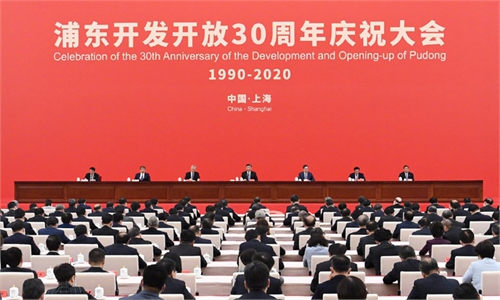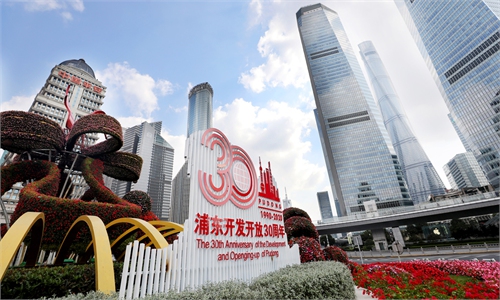Shanghai’s Pudong sets lofty goal
‘Shining pearl’ of great modern socialist country

A view of the Lujiazui financial hub in Pudong New Area Photo: VCG
China's central government on Thursday issued a guideline on building the Pudong New Area of Shanghai into a pioneer area for socialist modernization in the coming years.
Analysts said with its focus on the "dual circulation" paradigm, Pudong will become the hub of China when the country becomes the world's largest economy before 2035.
The guideline, jointly released by the Communist Party of China (CPC) Central Committee and the State Council, the cabinet, listed multiple measures to guide the Pudong New Area in forging its leadership position and driving Shanghai's efforts to lead Yangtze River Delta integration, and build the area as a shining window of a modern socialist country.
By 2035, Pudong will see that its modernized economy will comprehensively be established, modern urban area built, and modern governance fully realized. Its urban development level and international competitiveness will be globally leading, said the guideline.
By 2050, Pudong should become an important urban area that is highly attractive, creative, competitive and influential internationally, becoming a global model of urban governance and the "shining pearl" of a great modern socialist economy.
The guideline said that Pudong should continue to pursue high-quality reform and opening-up, and forge a central hub of domestic circulation and the strategic linkage of the "dual circulation" development paradigm.
Tian Yun, a Beijing-based economist, told the Global Times on Thursday that Pudong will became a pioneer with its focus on the dual circulation paradigm.
"By 2035, China will be the world's largest economy with the world's largest manufacturing industry and Shanghai's Pudong will become a modern hub for the country," Tian said. "Behind it, lie the advanced high-tech industries of the Yangtze River Delta as well as national-level innovation bases - the embodiment of national strategic interests."
The outline of the new role for Shanghai's Pudong new area follows state designations for other competitive localities.
In June, Chinese central authorities issued a guideline designating East China's Zhejiang Province as a demonstration zone for common prosperity.
Another guideline was issued in 2019 for Shenzhen, South China's Guangdong Province, to build the city into a demonstration area of socialism with Chinese characteristics. A more detailed plan was released last year.
Tian said Pudong's role is different from that of Shenzhen, which is focused on boosting its integration with Hong Kong and the Greater Bay Area. "Pudong's role will be pioneering in nature."
In terms of being an international financial center, Pudong will be different from Hong Kong, as it will become the global financial center that primarily uses the yuan, Tian said.
The guideline issued on Thursday offers tangible benefits for research institutes by exempting import duties for equipment for research use. Companies in vitally important sectors - integrated circuits, artificial intelligence, bio-pharmaceuticals and civil aviation - will receive corporate income tax breaks for the first five years following operation.
The Pudong New Area should also set up a blockchain standard system for trade financing and conduct a pilot program for digital yuan.
"One highlight is the plan will build a special economic functional zone in Pudong that undergoes risk and pressure tests on the open economy," Sun Yuanxin, a deputy director of the Research Institute for the Shanghai FTZ at the Shanghai University of Finance and Economics, told the Global Times on Thursday, noting that the entire Pudong area will become a special economic zone in the future.
At present, the Lingang zone, a newly launched section of the China (Shanghai) Pilot Free Trade Zone, is a special economic function zone, but through the development of Pudong, it will lead the development of all five centers in Shanghai and further promote the integration of the Yangtze River Delta to better serve the whole country, the expert said.
Shanghai aims to build itself into an international science and technology innovation center, financial center, trade center, shipping center and consumption center.
The document also speaks of "formulating a list of special measures for Pudong to ease market access," which Sun said is an indication that Pudong will open up more vigorously than any other part of China.
China has set up 21 pilot free trade zones and attracts a rising amount of foreign investment, as it is becoming a more popular destination for overseas investors, media reports said.
Pudong will boldly shoulder the heaviest burden, "crack the hardest bone", and strive to become a pioneer in reform and opening-up at a higher level, the guideline said.
According to public information, since 1990, when the central government decided to allow Shanghai to accelerate the development of the Pudong new area, the district has made outstanding achievements, with its GDP exceeding 1.2 trillion yuan ($185.8 billion) in 2019.
Shanghai has also set out to become global commodities trading center, and by 2035 Pudong New Area is expected to have the same international influence as New York, Tian said.


